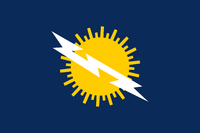United Army of the Liberation
| United Army of the Liberation | |
|---|---|
| လွတ်မြောက်ရေး၏ယူနိုက်တက်ကြည်းတပ် lwatmyawwatrayy Eat Yuunitetaat Kyitaut | |
 | |
| Active | 1964-1971 |
| Allegiance | |
| Type | Pro-Government Paramilitary Force |
| Motto(s) | Land, Sons, Arms! |
The United Army of the Liberation was a pro-Confederal paramilitary group that fought as part of the Royalist Coalition in the Trucial Wars, and was the precursor organisation of the modern Union Defence Force. Beginning as a Labour Battalion mutiny in the former Chauchua Autonomous Tribal Territory, that grew into an ethnic insurgency against mass conscription by the the People's Republican Army, the UAL proper was formed when the rebels joined forces with Tribal Protection Units from across the United Zomi Councils' border with the Zomi Confederal State. Despite an official ceasefire, these local militias had been fighting border skirmishes against Ryo socialist guerrillas for two years. Both the Confederal Government and the United Councils claimed the other side had violated the May Ceasefire Agreement of 1962, and their conflict resumed throughout Zomia.
The UAL was the first effective multi-ethnic force fielded against the UZC. Its numbers bolstered by enemy deserters and refugees fleeing agricultural collectivisation, by 1970 it had surpassed the Hsan Salvation Front in size. The ethnic Hsan-Lue militias of the HSF had been the main armed wing of the Confederal government throughout the Trucial Wars, and a destructive rivalry developed between the paramilitaries, clashing with each other as much as the enemy in the race to take the capital. The HSF's victory was expected: Hpkeng II had prohibited the supplying of arms to the UAL in 1968, fearing a threat to Lue minority rule, and it is believed he intended for the HSF to destroy the UAL once the war against the UZC was won. Unbeknownst to Hpkeng II or the HSF, however, the UAL was backed by Anwra I Sah Israt, Sah of Hànua, and the most powerful princely ally of the Paramountcy. Anwra I disobeyed the royal sanction, supporting the UAL with less overt forms of aid: vital intelligence on the HSF's operations, and officers of the Trucial Rangers loyal to the Israti Clan, who provided professional training to UAL militants and co-ordinated their logistics. By the war's end, Anwra I had become the de facto commander of the UAL, and it was forces loyal to him that seized the capital on March 17th.
The HSF's indiscriminate violence towards the Paramountcy's hard-won allies had only increased as the UAL surpassed them, and their loyalty, discipline and usefulness was called into question. Gradually Hpkeng II's favour waned. The final straw for the HSF came several months after the victory at Cireram - following the disastrous Teyvada Crossing Incident of 1971. Emboldened by anti-socialist unrest in neighbouring Lavana, HSF militants deserted their lines and looted villages across the border - drawing several hundred militia and a patrol group of Trucial Rangers into a confrontation with the Lavanan Army. The diplomatic repercussions - and the HSF militants' bloody defeat - was a great humiliation for Hpkeng II's newly established Union regime, and he swiftly ordered the leadership of the HSF purged. The remaining Union-aligned paramilitaries were consolidated into the Union Defence Force, of which UAL militants loyal to Anwra I constituted the majority. The supremacy of Hànua over the Paramountcy in Cireram was now uncontested, and the position of Prime Minister, the Union's nominally elected head of government, has been held by the Sah of Hànua to the present day - often considered the power behind the throne.